The next day I explored the town, beginning with the
bewitching assemblage of 20th-century art at the Rosengart
Collection. It has some great stuff. Renoirs share wall space with Legers and
Kandinskys, and there is a roomful of Chagalls, each one of them suffused with
love and sorrow: David Mourning His Son Absalom, Les Amoureux, a Christ
crucified alongside a longcase clock… The Rosengarts – father and daughter –
were friends and patrons of Picasso, and works by him form the heart of the
collection. There are lots of drawings, including a sketch of a mother and baby
that is as subtle and profound as a Da Vinci Madonna. Some of these figurative
works are much later than one might expect – they were produced long after
Picasso began doing his fractured, kaleidoscopic compositions of violins and
newspapers and music stands. You get the feeling that he was far too big an
artist to be constrained by one style or movement – that he was a cubist only
when he was in the mood for it. And, even in this smallish collection, you
cannot help but be impressed not just by Picasso’s versatility, but also by his
sheer output: the paintings and pots and sculptures seem to have poured out of
him in a torrent, like the waters that gush through the Nadelwerk.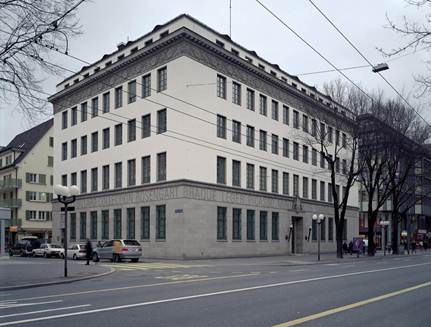
the Rosengart
Collection
It is a short walk from the Rosengart Collection back to the
KKL. Right at the top of the buildings is the Kunstmuseum, Lucerne’s showcase
for contemporary art. I happened upon a fabulous travelling exhibition of works
by Chinese artists. I saw an astonishing maquette, a scale model representing
the clifftops and palaces of Tibel. It hung from the ceiling and was made from
edible dog chews that had been unfurled and stitched together. There was also a
tiny piece by Ai Weiwei: an ashtray-sized ceramic of a rolling wave, like a
Hokusai in miniature 3D.
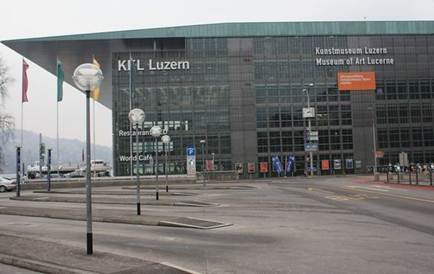
the Kunstmuseum
Come the evening I wandered off into the Old Town. It is at
its best at twilight, when the shops are shut, the streets empty, and your eyes
naturally drift upwards to the decorative frescos on the facades of the
buildings. There are tall paintings of tradesmen and shopkeepers, announcing
the kind of shop that is housed below (or once was). In places, plaster saints
balance on plinths installed at first-floor level; elsewhere there are wooden-
framed frontages like Jacobethan manor houses – only here the wood is carved
into pleasing curves and picked out in oxblood tones. Many of the older
buildings are capped with chaotic, whimsical roofs featuring turrets and towers
and gabled windows barely big enough to put an arm through. The Old Town is
dotted with open squares (each one with a fountain at its centre) where you can
sit down with a glass of wine to enjoy the architecture.
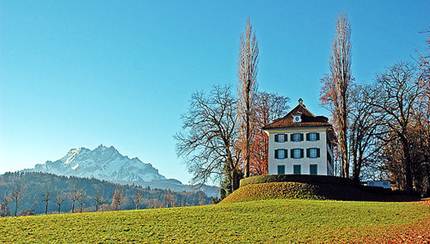
Wagner’s house
The next day was a Sunday, and my last morning in Lucerne. I
got up early and went for a walk to Wagner’s house, which I had seen from the
boat. The first five minutes led me through railway sidings and boatyards
behind the KKL, but soon I was in a pleasant park. I nodded Guten Morgen to the
joggers and dog walkers, and watched a few intrepid swimmers tiptoeing past the
drowsy swans to take a dip. Walking on, I soon found myself at the bottom of
Wagner’s garden, where his sloping lawn meets the shore. The water was opaque
and silvery at this hour, like mercury. Mists rose in wispy strands from
between the pale mountains. It was a Romantic artist’s dream of a landscape:
not hard to see why this place appealed to a big-canvas composer such as
Wagner.
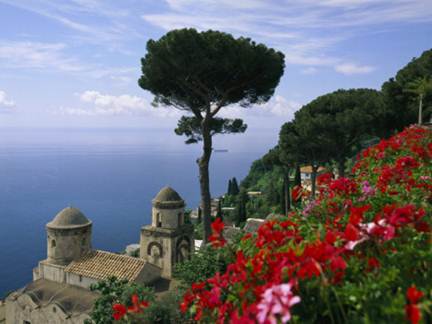
the bottom of
Wagner’s garden
It was, however, a little chilly, and I wondered whether I
should postpone visiting the house and go in search of coffee and a piece of
cake. Suddenly the church bells of Lucerne began to chime all at once. Their
pealing reverberated round the lake in such a way that it was impossible to
tell which direction the sound was coming from. The bell- music just filled the
air and – though it was an illusion – seemed to be making ripples on the
surface of the water. I tell you: it was as if those mountains were singing to
each other.
Where to stay
The Hotel - Jean Nouvel’s hip boutique hotel on the south
side of the river, a short stroll from the station. In each bedroom the ceiling
is a huge mural depicting a (faintly erotic) still from a film that means
something to Nouvel: That Obscure Object of Desire, The Pillow Book, Last Tango
in Paris, The Sheltering Sky. Definitely the coolest hotel in town. Sempacherstrasse
14 (00 41 41 226 8686; www.the-hotel.ch).
Doubles from SFr375 (about $390)
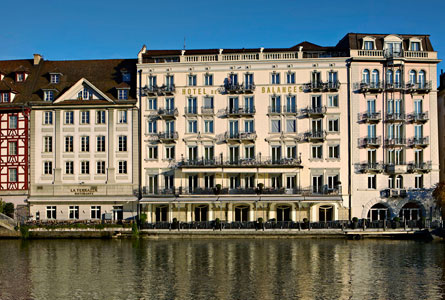
Hotel des Balances
- Old- world
Hotel des Balances - Old- world but very stylish hotel in
the heart of old Lucerne. It overlooks the river to one side and the Weinmarkt
to the other. There is a fine restaurant, but this is also a terrific place for
an aperitif. Weinmarkt (00 41 41 418 2828; www.balances.ch).
Doubles from about $360
Where to eat
Bam Bou - French- Asian fusion restaurant in the basement of
The Hotel. Terribly chic. Sempacherstrasse 14 (00 41 41 226 8686; www.the-hotel.ch). About $85 for two without
wine.
Where to drink
Rathaus Braverei - A little micro- brewery on the riverside,
underneath the Old Town Hall. The beer is excellent, and so are the brezels –
sandwiches made with plaited bread. Unter der Egg 2 (00 41 41 410 5257;
rathausbrauerei.ch). About $10 for a brezel
What to do
Walk the lakeside - Go round the south shore to Wagner’s
house (www.richard-wagner-museum.ch),
or take the north shore to the Verkehrshaus der Schweiz transport museum (www.verkehrshaus.ch)
Climb the walls - The view from the remains of the medieval
city walls is lovely.

Switzerland's
longest summer toboggan run
Ride a toboggan - Switzerland’s longest summer toboggan ride
is at Frakmuntegg, on the slopes at Pilatus. Get there on the gondolas from the
Lucerne suburb of Kreins.
Soak up some culture - Catch a concert at the Kultur- und
Kongress – zentrum (www.kkl-luzern.ch),
or see modern art in the Kunstmuseum at the top of the building (www.kunstmuseumluzern.ch). Visit the
Rosengart Collection for Picasso and his 20th- century peers (www.rosengart.ch).
Getting there
Swiss - (www.swiss.com)
files to Zurich, then take the fast train to Lucerne. A 1hr 45min flight to
Zurich, then an hour’s train ride.